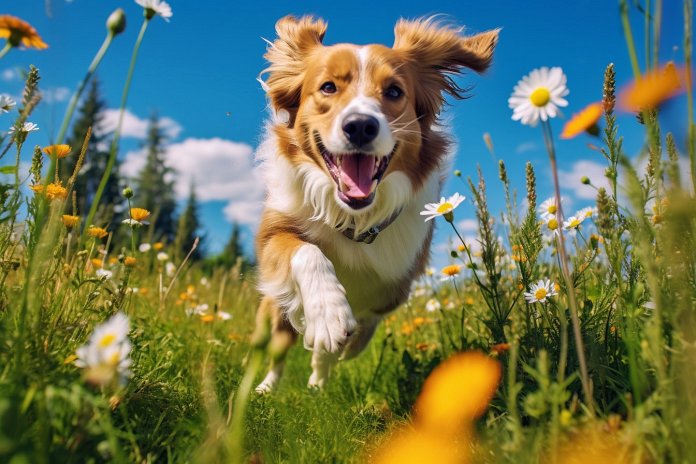
The feeling of freedom is important to humans and dogs alike, but can dogs truly experience freedom like we do? While the nuances of freedom may be beyond a dog’s emotional capacity, there are aspects of freedom that dogs can enjoy. They may appreciate being released from confinement or enjoy being in an open space. Ongoing research into canine emotions may provide a better understanding of how dogs think and feel, but for now, let’s explore how our furry friends experience freedom.
Signs That Dogs Feel Freedom
When dogs feel free, they may show signs of happiness and contentment. They may eagerly explore their surroundings, run, jump, and bark. However, it’s important to watch for signs of over-excitement, such as excessive panting, to ensure they don’t become overexerted. In some cases, dogs may not enjoy the feeling of freedom and prefer the security of confinement due to past traumatic experiences, separation anxiety, or clinginess. These dogs may display behaviors associated with agitation or fear, such as whining, crying, pacing, or cowering.
Body Language
Signs that a dog is feeling free include panting, jumping up, wagging their tail, and raising their ears. Other signs may include running around, trying to escape when confined, and being happy when off-leash.
History of Dogs Feeling Freedom
While there have been no specific studies on the feeling of freedom in dogs, research has shown that dogs can associate freedom with happiness. Canine behavior is influenced by psychological triggers, and their brains make connections to bring about a positive response to freedom. On the other hand, dogs may perceive freedom as a reason to be fearful and behave in a way that protects their survival. This can be seen in dogs that stick by their owner in wide open spaces.
Science of Dogs Feeling Freedom
The neurological pathways in dogs are similar to those in humans, and neurotransmitters and hormones play a role in their emotional and physical responses. However, the process by which dogs process emotions is less complex than in humans. An imbalance of neurotransmitters can affect a dog’s behavior and cause unexpected reactions to familiar situations.
Training Dogs to Feel Freedom
While dogs may not be able to isolate the feeling of freedom, training techniques can help them enjoy new or open spaces if they currently find them frightening. Gradual exposure and positive reinforcement are key aspects of this approach. Gradually introducing dogs to challenging situations and rewarding their calm behavior can help them overcome their fears and become happy and confident in open spaces.
“Training techniques and gradual exposure can help dogs overcome fear and enjoy the freedom of open spaces.”

Tips & Things to Know
1️⃣ Pay attention to your dog’s body language: Look out for signs of contentment, such as wagging tail, raised ears, and jumping around, when your dog experiences freedom. Also, be aware of signs of over-excitement or fear, such as excessive panting, pacing, and cowering.
2️⃣ Understand that not all dogs enjoy the feeling of freedom: Some dogs may prefer the security of being in a crate or staying within the parameters of the home. This could be due to past traumatic experiences, separation anxiety, or clinginess due to stress, illness, or old age. Respect your dog’s preferences and provide them with a safe and comfortable environment.
3️⃣ Use gradual exposure and positive reinforcement to help your dog overcome fears: If your dog is afraid of certain situations or environments, gradually expose them to those situations in short bursts and provide positive reinforcement when they exhibit calm behavior. This can help them become more comfortable and confident in open spaces.
Frequently Asked Questions, Answered ✅
1. Can dogs experience freedom in the same way humans do?
It is unclear if dogs can experience the same nuanced feeling of freedom as humans, but they can enjoy certain aspects of freedom such as being in a wide open space or being released from a crate.
2. How can you tell if a dog is feeling free?
Signs that a dog is feeling free include running and jumping around, barking, wagging their tail, and having raised ears. They may also show signs of over-excitement such as excessive panting.
3. Are there instances where a dog does not enjoy the feeling of freedom?
Yes, some dogs may prefer the security of being in a crate or staying within the parameters of their home. This could be due to previous traumatic experiences, separation anxiety, or stress.
4. What are signs that a dog is fearful of freedom?
Signs that a dog is fearful of freedom include whining, crying, howling, pacing, shaking, cowering, ears down, and reluctance to leave their owner’s side.
5. How can dogs be trained to feel more comfortable with freedom?
Dogs can be trained to feel more comfortable with freedom through gradual exposure and positive reinforcement. This involves gradually introducing them to the situation that causes distress and rewarding calm behavior.